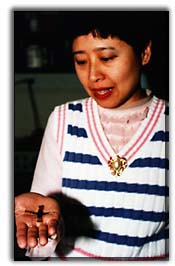| VOLUME 29, NUMBER 22 | THURSDAY, FEBUARY 26, 1998 |
New level in 'smart' materials; Carbon composite is semiconductor, Chung discovers
By ELLEN GOLDBAUM
The discovery lays the foundation for structural electronics, a new technology with the extraordinary potential to endow structural materials with electronic capabilities without computer chips or electrical leads.
"This is a whole new level of 'smartness' in materials," said Deborah Chung, professor of mechanical and aerospace engineering and principal investigator. "We can use the structural material itself as the electronics."
The research will be presented Wednesday at the International Symposium on Smart Structures and Materials.
Chung, who also is Niagara Mohawk Chair of Materials Research, co-authored the paper with Shoukai Wang, a doctoral candidate in the Department of Mechanical and Aerospace Engineering.
Made from carbon fibers embedded in a polymer matrix, the new semiconducting material would be easier and less expensive to fabricate than traditional silicon-based electronics. Because it would spread electronic capabilities over a much larger surface area, heat dissipation-now one of the biggest technological challenges facing electronic packaging-would no longer be a problem.
Known for their durability and light weight, carbon composites primarily are used to manufacture aircraft parts, and increasingly are being used in automotive components, bridges, machinery and sporting equipment.
Currently, optical or electronic sensors for detecting strain and deformation are embedded in carbon composites used to make aircraft parts, a process that itself can weaken significantly the structural component.
"In addition, these devices can only be embedded in certain locations, not throughout the whole component," said Chung.
"With this material, the whole piece is 'smart' and no electrical interconnection is needed," she said.
A structural electronic material also would have exceptional energy-storage potential, she added, allowing an aircraft component to act like a huge solar cell.
It also would make solar cars more feasible because energy could be stored throughout body panels constructed of carbon composites.
The discovery is unusual because it unites advances in two disciplines that typically don't "talk" to each other, Chung explained.
"In the semiconductor world, silicon dominates so completely that people tend not to think about other kinds of materials, especially structural materials," she said. "On the other hand, structural engineers would never think of their materials as semiconductors."
Chung, who is a materials engineer, made the discovery while examining the electrical behavior of carbon composites as a way to improve damage detection. She was focusing on how changes in temperature in composite structures could be sensed using the structural material itself.
She found that the electrical properties of the composite material changed with temperature.
"That variation in temperature is a signature of a semiconductor," she said.
"But what's even more unusual about this particular material is that it is semiconducting in one direction and metallic in another," she said. "Usually, a semiconductor, like silicon, is semiconducting in all directions."
The research shows that the carbon-fiber composite, consisting of layers of carbon fibers, is semiconducting perpendicular to the plane of the junction where the fibers intersect and metallic along its horizontal plane.
The advantage of having both in one material, Chung explained, is that the metal characteristics provide a system of built-in electrical contacts and leads for the composite to which a meter can be connected directly.
In addition, she said, by using the fibers as a conductor and putting an insulator in between the fiber layers, a large capacitor is formed, so that energy can be stored throughout an aircraft or automotive component made of the composite.
Chung plans to focus on optoelectronic and electronic devices made from the composite.
A patent has been filed on the invention.
News Services Editor
A UB engineer has made the first observation of semiconducting behavior in a carbon composite material, a finding that could revolutionize the fields of "smart" structures and electronics. The new technology could make possible aircraft components that are themselves huge energy-storage devices, solar cars whose body panels are capable of storing tremendous amounts of energy from sunlight and, eventually, even computers without chips.
The new technology could make possible aircraft components that are themselves huge energy-storage devices, solar cars whose body panels are capable of storing tremendous amounts of energy from sunlight and, eventually, even computers without chips.
Current Issue | Comments? | Archives | Search
UB Home | UB News Services | UB Today